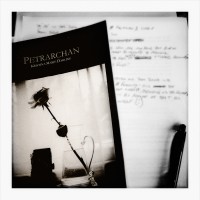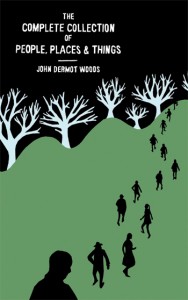25 Points: Brushes With
 Brushes With
Brushes With
by Kristina Marie Darling
BlazeVOX [books], 2013
50 pages / $16.00 buy from BlazeVOX or Amazon
1. This is Kristina Marie Darling’s 11th book of poetry; she is not even 30 years old yet.
2. Darling eschews traditional forms of poetry in favor of her own unique formal constraints: the use of footnotes, appendixes, images, definitions, bracketed verse, and erasure poetry. However, in Brushes With, Darling adds a new form to her repertoire: the narrative prose poem.
3. The collection begins: “We were no longer in love. The sky, too, was beginning to show its wear.” From this point forward, readers are plunged into many complex layers of the rubble of abandonment and loss.
4. The footnotes serve as historical commentary on the prose text. This makes for a matrix-like experience. We are reading a person’s intimate words, but we also know that this text has been abandoned, then found, then studied, then put on display. This technique makes the experience of reading the prose poems feel illicit in some way. We are peering into a labyrinth of secrets that are not meant for our eyes, yet are now uncomfortably preserved and public.
5. Even while reminiscing on the relationship before its end, the speaker foreshadows doom: “You told me there was dark matter I couldn’t see. That every star is a dead star.”
6. The imagery, like the one above, proves to be richly complex. All stars are dead; therefore, that which enchants us, that which we wish upon, that which we map out, gaze upon, pray to, is also doomed. In every romantic union, there is something dark that we don’t see coming, yet we should be aware that it’s there.
7. In “Feminism,” the speaker states: “I began to realize the significance of this gesture. What is love but a parade of memorable objects, a row of dead butterflies pinned under glass?” Ouch!
8. The speaker’s take on love is relentlessly jaded, yet she comes to sharp edged truths. What is love but our desire to possess, collect, admire. Yet, in doing so, we must sacrifice the subject’s life.
9. Footnote 18. ‘This statue of the Holy Mother would later be found headless in a tiny museum in northern France.” Once again, we have worship, mementoes, collection, ownership—all leading to destruction. Facelessness.
10. The marriage documented in the book unravels due to affairs. READ MORE >
August 20th, 2013 / 5:22 pm
25 Points: Petrarchan
 Petrarchan
Petrarchan
by Kristina Marie Darling
BlazeVOX [books], 2013
72 pages / $16.00 buy from BlazeVOX or Amazon
“Within every box, I found only compartment after compartment.”
1. Petrarchan is Kristina Marie Darling’s 8th book, published by the ever controversial Blaze Vox Books. (Yikes. Remember that whole thing? I still have love for the Vox, though.)
2. Much in the way she “took liberties with H. D.’s letters” in THE BODY IS A LITTLE GILDED CAGE, Darling uses ekphrasis, careful appropriation, erasure, and the work of Petrarch and Sappho (the latter, via Anne Carson’s translations) to achieve her grand illusion.
3. Kristina Marie Darling’s voice as a writer is unmistakable and unshaken regardless of mode or form. Of this, I am thoroughly convinced.
4. In fact, one thing that has repeatedly struck me about Kristina is how much larger in stature her writing voice is than its author. To be clear, this is not to reduce her as a person, but to exemplify her work as a force. Often, in an effort to amplify one’s voice over the din of modern media, the artist must become a personality first in order to gain potential interest in the work. Unfortunately, it becomes easy for the latter to suffer in the shadow of the former in the race. Darling reminds me that there is still a strong argument to be made as an artist for placing one’s ambitions squarely on the body of one’s art.
5. This is to say that I have no idea whose parties she attends, under which influences, et cetera, but I damn sure know when it’s her voice there on the page.
6. The reader will find in Petrarchan Darling’s familiar signature use of spare narrative and spectral imagery driving a carefully plotted course of marginalia and footnotes. To be fair, it is doubtful that anyone who is unconvinced or maybe even still undecided about her work in general will be swayed by Petrarchan. However, those of us who are believers or even simply interested parties will take comfort in knowing that what is gold still shines.
7. Tangentially, I have been thinking a lot about appropriation and erasure lately. As a writer who uses both at times almost criminally, I think a lot about what constitutes successful employment. After all, as some will invariably argue, can’t anyone do it? The short answer, of course, is yes. But to make a piece of erasure or other appropriation both successful and original despite its sources, I believe what the author chooses not to use, and why, becomes equal in importance to what is used, and how. The author must rely on the source text to some degree, but the artistic voice of the finished piece should stand on its own. Darling’s work—and Petrarchan is no exception—is as fine an example as any to underline these values.
8. I am thinking about corridors—hands and bricks or wood and the long-form sound of feet moving to some god knows where. I think about corridors a lot I think. I wonder if Kristina does too.
9. It is often easy to forget how the author implies a larger body of text with her use of marginalia as sparse narrative, set toward the bottom of the page, soaking up the white space of the specter it has picked apart.
10. Again, the ghostly presence hovering in the frame of the footnoted sections is largely the work of Francesco Petrarch, whose work I am largely unfamiliar with. I should really make it a point to change that. READ MORE >
August 13th, 2013 / 12:09 pm
Nate Pritts’s Big Bright Sun
 Big Bright Sun
Big Bright Sun
by Nate Pritts
BlazeVOX, 2010
100 pages / $16 Buy from Amazon
Nate Pritts’s Big Bright Sun celebrates witness, of one’s self and the self’s relationship to the world.
September 16th, 2011 / 11:00 am
Interview with John Dermot Woods
 I’m pretty sure John Dermot Woods hasn’t killed any presidents, but he still opts to use his assassin name on the cover of his book, The Complete Collection of People, Places & Things (BlazeVOX 2009).
I’m pretty sure John Dermot Woods hasn’t killed any presidents, but he still opts to use his assassin name on the cover of his book, The Complete Collection of People, Places & Things (BlazeVOX 2009).
That’s a title worth remembering, but I don’t blame anyone who can’t do it. I always call it The Complete List of Stuff, even though John’s title is better. I like how he places no limit on what is included. Apparently, it is the complete collection of everything and everyone, everywhere, ever. READ MORE >
John Dermot Woods’s The Complete Collection of people, places & things
I just ordered this: so too should you: John Dermot Woods’s The Complete Collection of people, places & things, which is surely to be wholly wonderful and grand.
PRE-ORDER SPECIAL!
Order The Complete Collection of people, places & things by July 15 and get it for only $12 (25% off the cover price) with free shipping in the U.S.
EXTRA STUFF FOR THE FIRST 50 PEOPLE WHO ORDER:
– A signed/numbered screen print, commemorating the book’s release
-personalized copy with a limited edition, signed book plate
(be sure to specify your shipping address)
The Complete Collection of people, places & things
a novel by John Dermot Woods
BlazeVOX Books 2009
ISBN: 9781935402466
175 pp. Perfect Bound. With Drawings.
BlazeVox; free ebooks out the ass
 I knew BlazeVox had ebooks, but I had no idea of there were more than 60.
I knew BlazeVox had ebooks, but I had no idea of there were more than 60.
In particular, there is a brand new e-title from one of my recent favorite people:
Sean Kilpatrick’s THE MAN WHO FOLLOWED ME HOME FROM WORK: Sean is just a slayer and will say anything, and his power comes through in the lines. I am excited for this compendium of his earlier stuff.
Also free are books by Ted Pelton, Juliet Cook, and Mark Cunningham, among others. A great trove of stuff.
Looking through this, then, also inspired me to take up their 3 for $20 deal on print titles, which includes ones from Louis E. Bourgeois, Michael Basinski, Daniel Borzutzky, Noah Eli Gordon and more.
If that isn’t enough, there’s also a new issue of their e-journal, which has the badass Brandi Wells, among many others.
Get to work.
